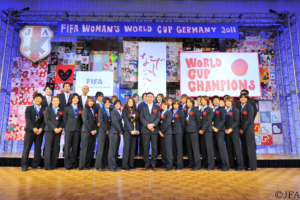“History of the Nadeshiko League” 18. The Great East Japan Earthquake and Nadeshiko Japan’s Spectacular Success
From the time when it was still unusual for women to play football, through to the birth of the Japan Women’s Football League, victory in the Women’s World Cup, and creation of the Japan Women’s Empowerment Professional Football League, social conditions and the environment surrounding girls’ and women’s football have undergone great changes.
We intend to publish a series of 22 articles before the end of the year in which we will look back over the tempestuous history of girls’ and women’s football in Japan.

On the afternoon of March 11, 2011, a major earthquake of magnitude (M) 9.0 occurred in the Pacific Ocean off the coast of Tohoku region. In addition to massive tremors like never experienced before, it generated huge tsunami waves, exceeding 10 meters in some places, and these crashed into the Pacific coastline of Tohoku, leading to an incident at TEPCO’s Fukushima Daiichi nuclear power station. The overall disaster led to more than 18,000 fatalities and missing persons.
That year’s Nadeshiko League had been scheduled to start on April 3, however, due to the major disruption caused to power supply and transportation by the Great East Japan Earthquake, this had to be postponed. An even greater impact was felt by TEPCO Women’s Football Club Mareeze, which had been developing into a Division 1 powerhouse.
This team was formed when YKK Tohoku Ladies Soccer Club in Miyagi Prefecture was transferred to Tokyo Electric Power Co., Ltd. in 2004. It primarily conducted activities out of the J-Village National Training Center that was established in 1997 in the towns of Taruha and Hirono facing the Pacific Ocean in Fukushima Prefecture. On the day of the earthquake, the team members were on a training camp in Miyazaki Prefecture and unharmed, however, because J-Village became the response center for dealing with the nuclear incident, it could no longer be used for football activities. On April 11, TEPCO announced the “temporary suspension of activities” of Mareeze and its other sports teams so that it could concentrate on the incident response effort. As a result, when the Nadeshiko League did get underway on April 29, only nine teams were competing, one less than the intended number.
Many of the Mareeze players continued playing football by securing temporary loans to other teams. Also, thanks to the efforts of Japan Football Association and the Nadeshiko League, J. League team Vegalta Sendai established a women’s team in the fall of that year and secured participation in the “Challenge League”, which was equivalent to Division 2, and many of the Mareeze players moved to Vegalta Sendai Ladies in 2012.
That year’s Challenge League saw teams divided into the EAST and WEST group leagues. The EAST group included Tokiwagi Gakuen High School Soccer Club and JFA Academy Fukushima in the disaster-affected areas of Miyagi Prefecture and Fukushima Prefecture, and these teams were also impacted considerably. Tokiwagi Gakuen had to play its opening home game with SFIDA Setagaya FC on April 10 at Yumeria Stadium in Iwata City, Shizuoka Prefecture, while JFA Academy moved its base to Gotemba City, also in Shizuoka and subsequently played all of its home games there.
The Great East Japan Earthquake resulted in massive material and human damage; moreover, due to uncertainty surrounding the reconstruction effort and cleanup of the nuclear incident, a power supply crisis and so on, Japan was enveloped in gloom for months after the earthquake. However, women’s football provided a ray of hope in the darkness. This was the victory of Nadeshiko Japan in the 6th FIFA Women’s World Cup.
Nadeshiko Japan, which was playing in its sixth consecutive FIFA Women’s World Cup, beat Germany, the host nation and one of the tournament favorites, in the quarter-finals thanks to a goal by forward Karina Maruyama (the ace player of Mareeze until 2009), and then beat Sweden 3-1 in the semi-finals. The final game against the United States took place early in the morning of July 18 (Monday) Japan time, and since this also happened to be a national holiday (Marine Day), the nationwide broadcast of the game on Fuji TV attracted a high audience rating of 21.8%.
It was a thrilling game, with America taking the lead two times only to be pegged back by Japan each time. With the United States leading 2-1, Homare Sawa grabbed a dramatic equalizer in the 27th minute of extra time (3 minutes remaining) by meeting a corner kick taken from the left by Aya Miyama at the near post, jumping and connecting with the outside of her right foot to score. The game went to penalty kicks, in which the Japanese goalkeeper Ayumi Kaihori saved two of America’s kicks and Saki Kumagai scored the winning penalty high into the left side of the goal to ensure Japan’s victory.
Everybody in Japan was deeply moved by this performance. Moreover, people struggling to recover in the aftermath of the Great East Japan Earthquake were greatly uplifted by the example of the Nadeshiko Japan players, who kept believing in themselves and each other, pulled together and played fairly in the face of great difficulties. This year also marked the 100th anniversary of Japan Football Association, however, nothing in the history of football in Japan had imparted such an impact on Japanese society than Nadeshiko Japan’s World Cup success.
Naturally, the Nadeshiko League attracted a lot of attention following the World Cup. INAC Kobe Leonessa, which had seven Nadeshiko Japan players including Sawa and Kaihori, attracted almost 20,000 fans on average to its home games after the World Cup. Moreover, the average attendance at this year’s league games was 2,796. The Nadeshiko League was about to enter a new age of dramatic growth.
Yoshiyuki Osumi (football journalist)






